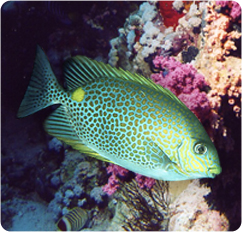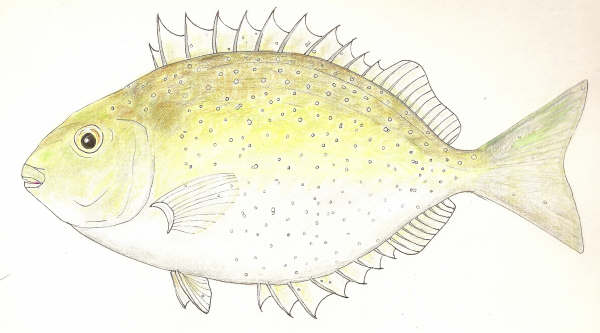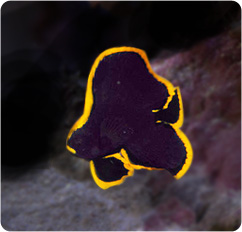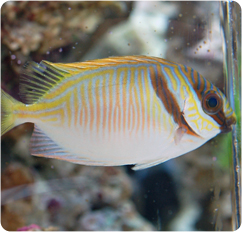|
Sleeper Cells and Unusual Suspects - Herbivorous Fishes; Part II
Some of the Most Important Grazers May Surprise You
Part II in a Three Part Treatise on Herbivorous Fishes, Tropical Reefs & the Aquarium Industry Herbivorous fishes are the primary grazers in reef ecosystems, and many are fantastic aquarium fishes as well. They control marine algae growth, enabling new coral recruits to effectively compete for space, thus contributing to the overall health of both the reef and the ecosystems aquarists attempt to replicate in their aquaria. But do we really know as much about herbivorous fishes as we think we do? In particular, do we understand their role on degraded reefs that have become algae-dominated? Some researchers suggest we still have a lot to learn.
Part I ~ Part II ~ Part III
 |
| Rabbitfishes like the Orange Spot are primary reef grazers. |
As discussed in part one of this three part series on herbivorous fishes, tropical reefs and the marine aquarium industry at large, the world’s coral reefs are in decline as evidenced by what is called a phase shift away from coral dominance and toward macroalgal dominance. Many marine scientists, like Peter Mumby whom we met in this series’ part one, “Queen of Green”, have associated this phase shift with overfishing of known herbivorous fishes such as parrotfishes and surgeonfishes. This association has led many in the scientific and conservation communities to call for the immediate protection of these species in an effort to reverse the degradation and enhance the resilience of tropical reefs.
While much of the work on herbivorous fishes and their role in reef resilience has taken place in the Caribbean, at least one researcher working on Australia’s Great Barrier Reef is beginning to call some of the basic assumptions about herbivorous fishes into question. Dr. David Bellwood, a researcher associated with the ARC Centre of Excellence for Coral Reef Studies and a professor at James Cook University, is one such scientist.
Scientists from Down Under Turning Conventional Wisdom Upside Down
 |
| Dr. David Bellwood, ARC Centre of Excellence for Coral Reef Studies and Professor at James Cook University |
Bellwood’s research focuses on the function of reef fishes within their ecosystems, using behavioral observations in the field, morphological analyses in the laboratory and behavioral and functional studies in aquaria. Bellwood has looked long and hard at comparisons between Caribbean reefs and the Great Barrier Reef in relation to algae growth and the recovery of degraded reef structure.
As part of their research, Bellwood and his team planted macroalgae assays—a common research technique—on a portion of reef and watched and waited. “To our surprise and disappointment,” says Bellwood, “the fish that usually ‘mow’ the reef—parrotfishes and surgeonfishes—were of little help when it came to suppressing well established weedy growth. Most herbivores simply avoided the big weeds.”
While it may have been surprising to Bellwood to see the best-known known grazing herbivores associated with coral reefs ignoring the macroalgae, what he saw next astonished him. Caught on underwater video footage, Bellwood watched in amazement as this macroalgae was consumed by some very unusual suspects.
“The rabbitfish (Siganus canaliculatus),” says Bellwood, “came out of nowhere and began to clear-fell the weed placed on the reef crest.”
 |
| The white spotted rabbitfish is tops when it comes to macroalgae. |
The white spotted rabbitfish (S. canaliculatus) was responsible for about half of the bites taken from the macroalgal assays. While not as effective as the white spotted rabbitfish at removing larger macroalgae tufts, the popular aquarium rabbitfish commonly called the scribbled rabbitfish (S. doliatus) was also a leading grazer in terms of bites taken. Bellwood explains, “Basically, the white spotted rabbitfish takes a lot of the bites and they are very effective. Siganus doliatus, on the other hand, takes almost as many bites, but these bites are a lot lighter and are not effective at removing the macroalgae.” More simply stated, Bellwood remarks, “There are bites and bites—not all bites are the same.”
If Bellwood and his colleagues were surprised by the efficacy of the white spotted rabbitfish when it came to mowing down macroalgae, nothing could of prepared them for the other fish that proved to be a voracious eater of macroalgae—Platax pinnatus. That’s right, the pinnate batfish, which is generally considered an invertebrate feeder, not an herbivore. According to Bellwood’s study, the 43 herbivorous fishes in the local fauna played only a minor role in the grazing of established macroalgae when compared to the pinnate batfish. In fact, it was the batfish that was primarily responsible for driving the phase-shift reversal of an algae-dominated reef to a coral-dominated reef.
“What was most surprising to us,” Bellwood says, “is that despite more than 50 years of SCUBA-based research on coral reefs, we were totally unaware of the fishes responsible for reversing the most widely documented phase shift in reef ecosystems.” To put it into scientific terms, Bellwood and his colleagues have suggested that correlations between herbivorous fish densities and macroalgal densities may not be causal relationships, and this potentially could change the approach to how we should deal with coral reef recovery around the world.
According to Bellwood, “it reveals an unseen vulnerability based on the naive assumption that functional groups believed to prevent phase shifts can also reverse phase shifts and thereby facilitate regeneration and rebuilding of ecosystems.” In short, Bellwood wonders if we’ve got it wrong when we focus solely on seeking protection for the known grazers in an effort to repair degraded reefs with established macroalgae growth.
Not So Surprising to Aquarists
The appearance of rabbitfishes at the study sites, and especially their role as primary grazers of macroalgae, may not surprise aquarists, who have long enlisted rabbitfishes for biological control of algae in their aquaria. It is not uncommon for an aquarist with an established hair algae problem, for example, to acquire a rabbitfish such as the scribbled rabbitfish to get their aquarium back under control. Once it is under control, the aquarist must of course address the root issues of their algae problem (often excessive nutrients), but in conjunction with addressing the root issue, many aquarists also elect to add some of the usual suspects in terms of the known grazers (e.g. yellow tangs, kole tangs, etc.) to keep the macroalgae from reestablishing itself. This example is a sort of microcosm of what Bellwood and his researchers have found.
As Bellwood explains, “Species or functional groups that prevent phase shifts may not be able to reverse phase shifts once they occur. Nevertheless, reversal is possible.” To return to the aquarium example, the experienced aquarist is probably not surprised the rabbitfish took care of the established algae on the “degraded” reef, while the surgeonfish maintains the reef once it is “recovered.” We should note here that rabbitfishes are to be considered reef compatible in aquaria only with extreme caution, but the take home point is the same. As Bellwood puts it, “the critical issue is to identify and protect those groups that underpin the resilience and regeneration of degraded reefs, acknowledging that these often are not the parrotfishes and surgeonfishes we count on to prevent the phase shift in the first place.”
Sleeper Cells
 |
| The Pinnate Batfish is an unlikely heroic herbivore. |
The pinnate batfish (Platax pinnatus, sometimes called the redfin batfish or the shaded batfish, was not connected with coral-algal interactions and associated phase shifts before Bellwood’s study. Batfishes represent what Bellwood calls a “sleeping functional group,” or, as he explains, “a species or group of species capable of performing a particular functional role but which does so only under exceptional circumstances.”
Is the pinnate batfish part of a kind of piscovory, environmental sleeper cell able to be roused into action by phase-shifts such as the ones Peter Mumby and David Bellwood have been studying? And if so, should this concern us considering that there are currently no regulations protecting batfishes (and possibly many other sleeping function groups)? After all, batfishes are comparatively rare on the Great Barrier Reef.
“[Batfishes’] vulnerability to overexploitation is enhanced by their size, sensitivity to spear fishing, and propensity for recruiting in coastal or mangrove areas, which are increasingly being degraded by terrestrial runoff, coastal tourism and coastal development. Indeed, this means that the resilience of inshore Great Barrier Reef reefs may be closely tied to the fate of mangroves and their suitability for batfish recruitment—something no one is looking at nearly as hard as protecting parrotfishes and surgeonfishes.”
As Bellwood points out, “sleeping functional groups like batfishes are arguably the most difficult to detect and protect because we do not know which species are important until conditions change.” Towards this end, Bellwood calls for “a two-pronged approach” for enhancing reef resilience: protection for the species that prevent phase shifts (e.g. parrotfishes and surgeonfishes) and protection for the species that facilitate reversal and recovery (e.g. rabbitfishes and batfishes). “We can no longer assume that simply reintroducing or protecting the species that prevented phase shifts will result in a reversal and permit regeneration,” says Bellwood.
These new studies have shown us that we may not know as much as we think we know about the role of herbivorous fishes, and more scientific data are definitely necessary to understand the functional capabilities of species we may once have thought were relatively unimportant in an ecological sense. Does this mean that the marine ornamental industry should stop dealing in rabbitfishes and batfishes, as part one of this article suggested it should do with parrotfishes?
According to Bellwood, no.
Rabbitfishes and Batfishes in Marine Aquaria
“Removal of herbivores is a problem, but, with the exception of Hawaii, removal for aquaria probably has minimal impact. It is fishing herbivores for food that is the real threat. Ornamental removal may be an issue in Hawaii [for a species like the yellow tang]—although the data seem variable, and I am uncertain how reliable, but people are looking at it—but yellow tangs are only one of several herbivores, the vast majority of which are not collected for aquaria but are eaten.” Further, unlike parrotfishes, both rabbitfishes and batfishes do quite well in aquaria, although the latter have much more specific habitat needs, and, as a result, should be kept only by experienced aquarists who can meet those needs.
Most rabbitfishes, in fact, make excellent aquarium specimens, although, as was already mentioned, they can only be endorsed for reef use with caution. Rabbitfishes are generally hardy, disease resistant, beautiful, and interesting fishes. “It’s actually a shame,” says Mark Martin, director of marine ornamental research at Blue Zoo Aquatics, “that rabbitfishes are not more popular in the hobby, especially considering how good they are at consuming algae of all kinds.”
Regarding batfishes, orbic batfish (Platax orbicularis) and teira batfish (Platax teira) do well in aquaria, but pinnate batfish are a little more difficult. “They really need a very peaceful community tank, and they need a ton of food,” explains Martin. “Batfish are sold as juveniles, and their metabolism is very high in this stage of life. Most will starve to death if fed on a typical aquarium feeding schedule, which is why we do not offer them to beginning aquarists.” One of the challenges with batfishes in the aquarium is that they grow very fast. “The adult terminal phase,” explains Martin, “makes a great fish for public aquaria or any other large display, but only juveniles are imported, and most outgrow their tanks in a matter of just a few years.”
The Importance of a Sustainable Marine Ornamental Trade
 |
| The Scribbled Rabbitfish is an Aquarium Favorite |
Bellwood is one marine scientist who sees real value in the marine aquarium industry, especially given the potential for education through aquarium keeping. “I strongly believe that a sustainable marine ornamental trade is a key component in securing a positive future for coral reefs,” he says. “Unsustainable practices are a problem. The thing is that people often assume that all collecting is unsustainable, and this is far from the truth.”
From Bellwood’s perspective, researchers have to be careful they do not make too many assumptions about herbivory. “People are now beginning to emphasize the role of herbivores and especially parrotfishes,” he says. "But we can not extrapolate from the Caribbean to the world and assume that all herbivores, or all parrotfishes, are the same. The bottom line is we do not know who the real herbivores are. Almost all available data are based on correlation NOT causation.”
Herbivorous fishes such as the rabbitfishes, surgeonfishes and parrotfishes are still present in relatively large numbers on the Great Barrier Reef, but, as Bellwood cautions, “This is not the case in other areas, where fishermen are increasingly targeting herbivorous fishes.” As a result, herbivorous fish populations throughout many locations in the Caribbean and the Indo-Pacific are in serious decline. “Some studies have shown that up to 90-percent of some species’ populations have been wiped out by overfishing,” Bellwood says. “With increasing stressors on coral reefs like climate change, ocean acidification, sea surface temperature rises, and the like, we are likely to witness more fast-growing marine algae competing with coral for space on the reef. The chances of corals re-establishing after a phase shift are not guaranteed.” As Bellwood has shown, however, when a full range of herbivores are present, not just the popularized parrotfishes and surgeonfishes recovery is possible.
In the end, we need the fishes we know about and some we have yet to appreciate. Without a better understanding—and protection based on that understanding—of sleeping functional groups like batfishes, some degraded reefs may have little hope of recovering.
“In short,” Bellwood concludes, “if the weed takes over, you’ve lost your reef. But, given the right herbivores, we can at least give them a chance to survive in this changing world."
Additional Resources
You can learn more about David Bellwood’s at the following websites:
The paper on Bellwood’s observations with rabbitfishes is titled “Remote video bioassays reveal the potential feeding impact of the rabbitfish Siganus canaliculatus (f: Siganidae) on an inner-shelf reef of the Great Barrier Reef”. It was published in the journal Coral Reefs in February 2008.
The paper discussing batfishes is titled “The Sleeping Functional Group Drives Coral-Reef Recovery”. It was published in Current Biology in December 2006.
To read part I in this series, “Queen of Green”, click here.
Published 10 June 2008. © Blue Zoo Aquatics
|